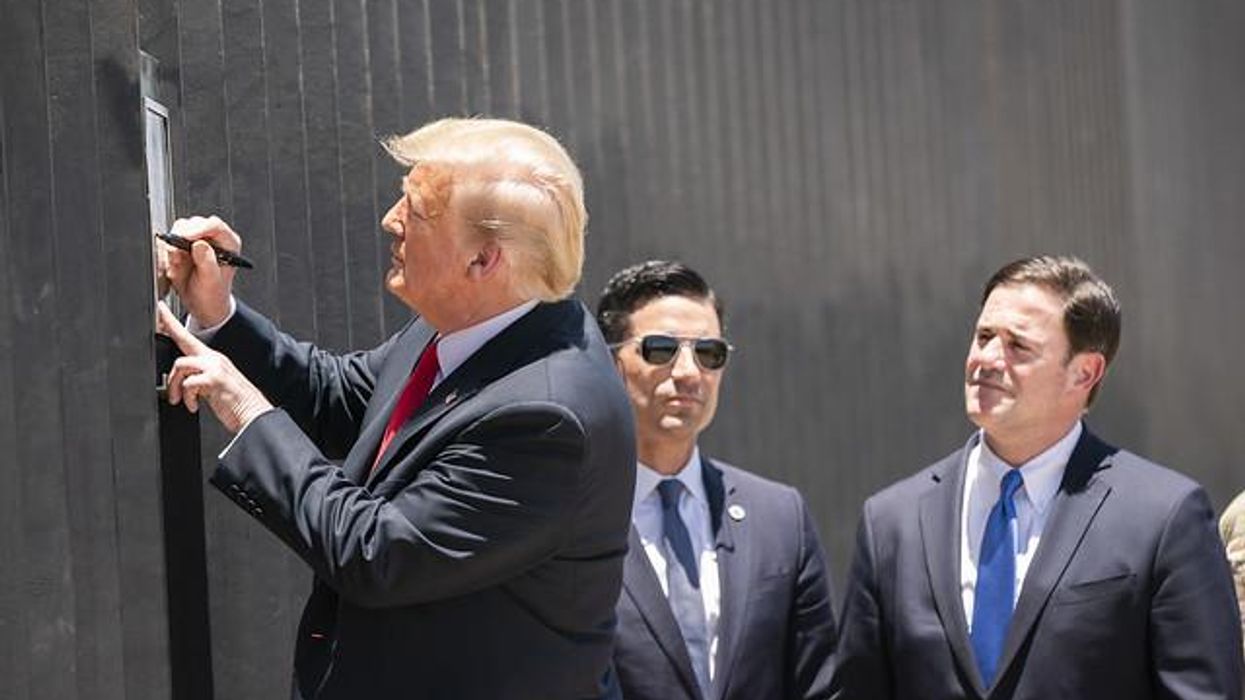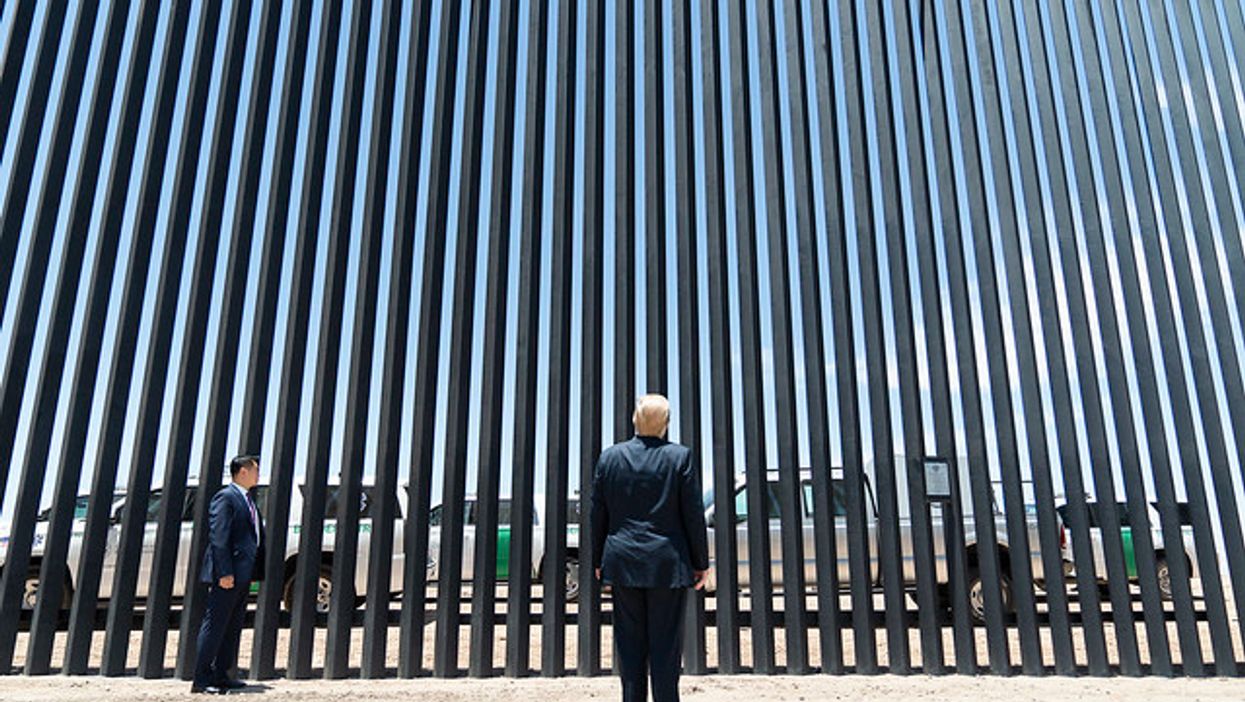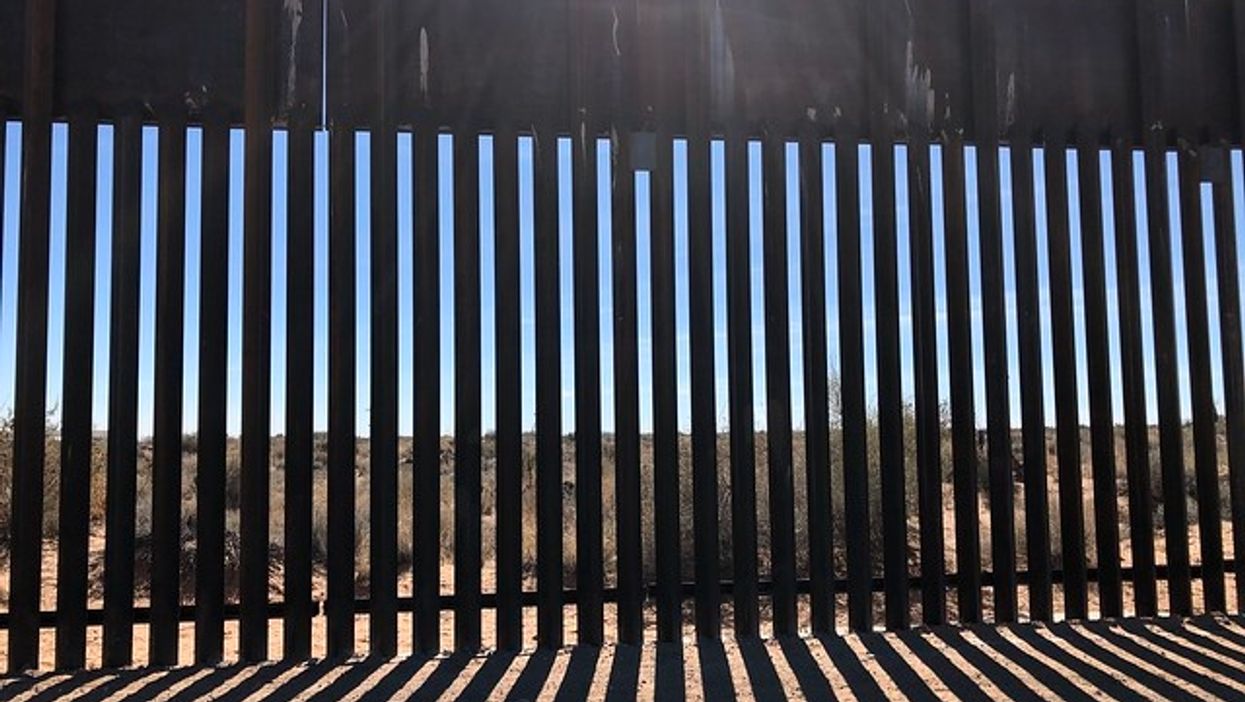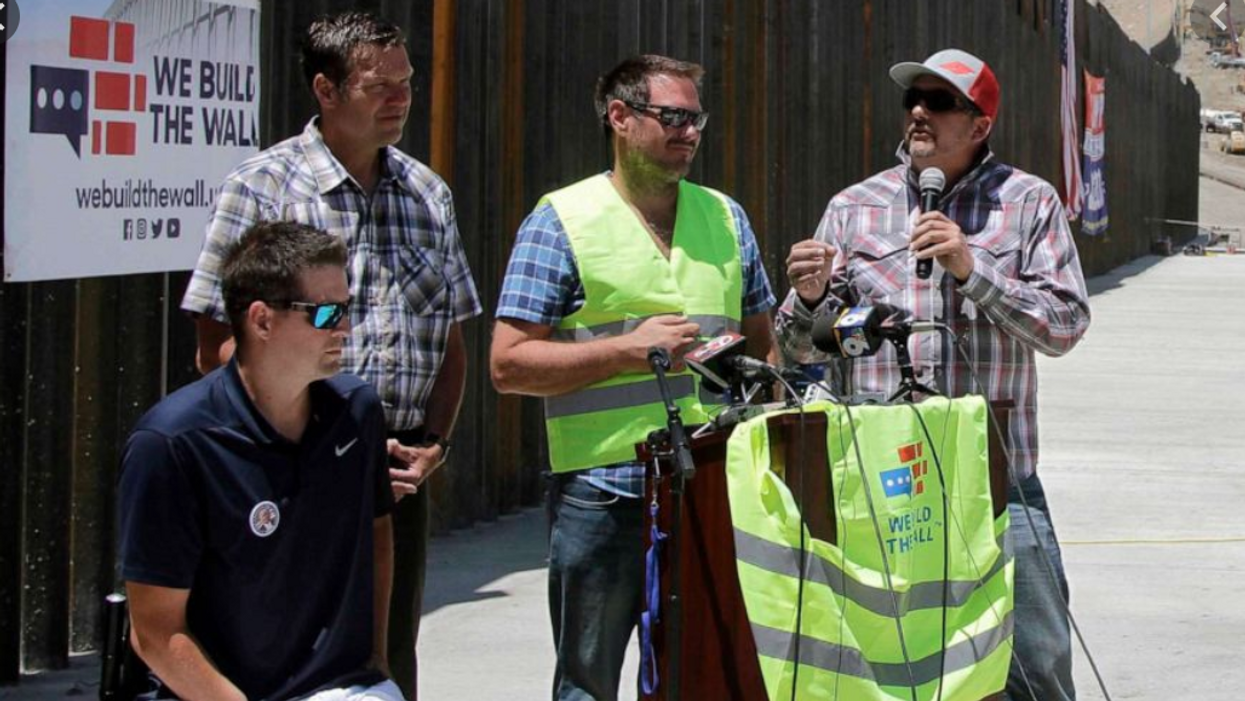Trump Still Authorizing Contracts For Border Wall — On Land That Government Doesn’t Own
Reprinted with permission from ProPublica
LA GRULLA, Texas — The federal government said it needed Ociel Mendoza's land on the outskirts of this tiny Texas town — and it couldn't wait any longer.
Each additional day of delay was costing the government $15,000 as contractors waited to begin construction on the border fence slated to go through Mendoza's ranch, the Department of Justice argued in court filings. By Nov. 24, the tab for the delay had reached nearly $1.6 million, the land acquisition manager for U.S. Customs and Border Protection said in an affidavit.
More than a year earlier, CBP had awarded a contract then worth $33 million to a New Mexico-based company to build four miles of fencing in Starr County. The county is one of the top targets of President Donald Trump's administration for a border wall and a place agents have called the most volatile stretch in the nation. Construction was slated to begin in November 2019, the agency announced.
There was one problem: The government had awarded the contract before obtaining the land it needed, including Mendoza's. This September, after more than a year without getting that land, CBP had to suspend the contract to Southwest Valley Constructors, accruing “substantial" charges along the way, according to court documents.
An investigation by ProPublica and The Texas Tribune has found that the government's strategy of awarding contracts before acquiring titles to the land in Texas has led to millions of dollars in costs for delays, according to calculations based on statements made by CBP officials in court filings. On at least two dozen occasions, the agency has used the argument, often successfully, to convince even dubious federal judges to immediately seize land from property owners fighting their eminent domain cases.
The situation could become even more complicated if President-elect Joe Biden makes good on his promise to stop border wall construction.
Mendoza, an entrepreneur, said the government's latest offer, which he said was about $136,000, fell short of the $200,000 he was seeking. The ranch is especially personal. It's a piece of land he vowed to own after he crossed the border illegally over the property as a teen more than 40 years ago.
“It represents a dream to me," said Mendoza, who became a permanent resident in the 1980s. “The American dream."
Since 2017, the federal government has awarded at least a dozen contracts in South Texas worth more than $2 billion prior to obtaining all the land it needed for the projects. The agreements are to build 146 miles of border wall and install nearly three dozen gates.
But very little construction has been completed. Out of the 110 miles the administration planned to build in the Rio Grande Valley, where most of the land is privately owned, 15 miles had been finished as of mid-December.
The Army Corps of Engineers generally requires land to be acquired prior to awarding contracts, but the policy allows exceptions if approved by high-level officials, said Grace Geiger, an agency spokeswoman.
While posing greater risks for the government, she said the practice doesn't have to lead to greater costs as, depending on the situation, the government may still be able to acquire the land before the contractor needs to enter the site.
Contract experts say the practice violates principles of sound procurement.
“It sounds like a formula for waste, or worse, to make the construction contract first and only acquire the land months or years later," said Charles Tiefer, a University of Baltimore contracting expert.
Austin Evers, the executive director of American Oversight and a senior counsel for the State Department during President Barack Obama's second term, said the practice should be investigated by federal watchdogs.
“The government is arguing that it has to seize these lands right now because it is being penalized under the contract it already signed," Evers said. “In plain English, what that means is that American taxpayers are seeing their money thrown away for no purpose because the government signed the contract before it could execute the project."
Federal judges hearing CBP's eminent domain cases in South Texas also have expressed frustration with the government's legal argument for immediate possession in Starr County. In recent weeks, a segment of border fencing has quietly gone up in a remote area near Mendoza's ranch.
While the government gets the title to the property as soon as it files what's called a “declaration of taking" and deposits the amount it deems reasonable with the court, it can't begin construction until a judge approves an order to possess the land. U.S. District Judge Micaela Alvarez, a George W. Bush appointee, blasted government attorneys' request to take immediate possession of Mendoza's ranch, arguing that the agency has had the funds to acquire private land in Starr County for nearly two years.
“The United States' delay until November 2020 to file its motion for possession is not within the Court's control ... and (does) not create an emergency for this court," she wrote Dec. 17. “The Court has repeatedly expressed its dissatisfaction with the United States' requests for expedited relief. The United States is not entitled to expedited relief, and should cease requesting such relief without good cause."
However, Alvarez said that under the Declaration of Taking Act, she had little option but to grant the government's request to take possession of Mendoza's land, noting that Mendoza had not responded in time and that the government had filed the correct documentation and deposited what it estimated it would pay for the land seizure.
Even as government attorneys continue to cite the growing costs of delays to judges, the agency has downplayed the issue outside the courtroom.
“CBP will not know if there are any associated delay costs due to real estate until the end of the contract, as the Contractor may be able to make up any potential delays incurred," CBP spokesman Matthew Dyman told ProPublica and the Tribune on Friday. Dyman declined to clarify the statement, citing the ongoing litigation.
CBP also insists that awarding contracts without first obtaining land is efficient.
“Once the border wall system design is approved by the Government, and sufficient real estate is acquired by the Government, construction activities can begin," wrote Roger Maier, a spokesman for CBP.
The government has been here before. A decade ago, CBP learned that building in this part of the border would be especially challenging, between acquiring the land — which in some cases took more than two years — and flooding concerns. Under the Bush and Obama administrations, several border wall fence projects, also awarded before the government obtained the land, died because the agency couldn't get them built before funding dried up.
The Trump administration's legal efforts have only intensified, with nearly 40 new eminent domain lawsuits filed in the Southern District of Texas since Election Day.
All of which leaves the incoming Biden administration and hundreds of Texas landowners in a web of title and compensation disputes, multimillion-dollar contracts and a string of unfinished — and disconnected — projects all along the Rio Grande.
Biden has said he will cease wall construction and drop all the lawsuits on day one. His transition team didn't respond to a request for comment as to how exactly the administration would go about canceling existing contracts nor what it would do with land it now owns as part of the eminent domain push. Biden could save up to $2.6 billion if he halts construction, according to Army Corps of Engineers documents reviewed by The Washington Post.
This will not be the first time Biden confronts this issue. Last time he was in the White House, the Obama-Biden administration allowed the lawsuits and contracts to proceed. By the end of their first term, 54 new miles of border fence had been built in South Texas.
Starr County
One of CBP's toughest fights over eminent domain centers on Starr County, a poor, mostly rural county where family properties date back to original Spanish land grants issued 250 years ago, well before the Rio Grande served as an international boundary.
For more than a decade, residents and county officials have resisted the agency's push to build a border wall in Starr County, which the government has said in court filings is the No. 1 county for narcotics seizures across the entire southern border of the United States.
Starr and neighboring Hidalgo and Cameron counties are part of the agency's Rio Grande Valley sector, which accounts for 40 percent of immigrant arrests and 43 percent of the marijuana seizures along the southwest border
Under the Trump administration, Starr has become one of the agency's top priorities for the border wall. Hidalgo and Cameron counties already have about 60 miles of border fencing, built upon concrete levee systems.
But Starr County, which lacks a levee system, had no wall before the Trump administration first proposed building there in 2017. Three years later, CBP has awarded contracts for 55 miles, but only about 5 miles have been built, mostly on U.S. Fish and Wildlife refuge land in remote corners of the county.
As it was a decade ago, the government's effort is once again mired in complicated eminent domain legal battles that have so far prevented construction on the remaining miles.
Of 70 condemnation cases filed by the government since September in South Texas, 53 are in Starr County, where the government has only accelerated legal action since Election Day (25 lawsuits have been filed in this county since Nov. 3).
In one case filed at the end of November, the government is seeking to seize a triangle of land smaller than 2 acres in the county. Despite the tract's small size, there are more than 30 individuals with possible ownership rights, scattered across Texas and as far away as Washington state, according to court records.
Lawyers say that as land has passed through the generations, many partitions have not been documented properly in official records, resulting in a thicket of potential land ownership that the government has struggled to unravel.
“The title issues in Starr County seem to be far more complicated and difficult than what we've seen in the other border counties," said Roy Brandys, an Austin-based eminent domain attorney who represents border residents in these cases. “On several of the cases we've been working on in Starr County, one of the reasons they have not progressed even faster is because the government and frankly, we as the landowners' representatives, are trying to work out the title issues before they move forward."
According to a recent Government Accountability Office report, title issues in Starr have slowed construction timelines considerably. “Some counties in South Texas, such as Starr County, do not have the infrastructure or funding to maintain recordkeeping systems," the report says.
But where the federal government sees as a maze of legal hurdles, local officials see a reflection of the region's heritage.
“For many, the land has been in their families for generations," said Joel Villarreal, mayor of the Starr County seat of Rio Grande City. “We have a large number of residents that own land and they are proud of that heritage to own land. They speak of it as something to be cherished, the idea of having land."
Fight Over Land
On a recent morning, Mendoza, 60, stood in front of his ranch as orange survey markers fluttered in the wind around him.
At regular intervals, he has built steps into his own mesh and metal tube fencing, allowing would-be border crossers to climb over. He said Border Patrol agents have asked him why he built them. “I tell them for one, I was undocumented when I came here," he explained. “And two, so they don't break down my fence!"
The ranch holds a special place in the heart of Mendoza, who owns several businesses and properties in Starr County. In 1979, he crossed the border as an undocumented immigrant, passing through the same piece of property on his way to a new life in Houston. Thirty years later he bought the ranch when it came up for sale, and he is loath to lose it.
If the wall comes through the front of his ranch as proposed, Mendoza said he would have to move the fence and an expensive front gate, as well as the corral for the 40 or so cattle he raises on the land. Worse, he said, the wall would render the ranch virtually worthless by placing it almost entirely behind the barrier.
“It won't have any value afterwards" he said. “Anything could happen on the other side of the wall. I won't be protected inside there."
The government first made Mendoza an offer to buy his land in April, according to court documents. Five months later, federal prosecutors sued to take part of his ranch, depositing about $93,000 with the court as a “just compensation."
The government claimed in Mendoza's case that the cost of suspending work was about $15,000 per day. In other cases, the government contended that delays have added as much as $100,000 per day, depending on the size of the contract, according to a review by ProPublica and the Tribune. The expenses came from what officials called de- and re-mobilization and from having equipment and crew on standby beyond the date construction was scheduled to begin.
In four Rio Grande Valley projects alone, where the government has detailed the costs of delays in court filings, the total is nearly $9 million, as of the date the court granted the order for immediate possession, which is when work can begin.
Despite not having been able to break ground in 18 months, the original $33 million contract to Southwest Valley Constructors is now worth $42 million thanks to contract options the government has exercised. An earlier review of federal spending data by ProPublica and the Tribune found modifications to contracts have increased the price of the border wall by billions, costing about five times more per mile than it did under previous administrations.
Francis Rooney, a Republican U.S. representative from Florida and longtime real estate developer, called the practice “ridiculous." From a contractor point of view, he said, there's the risk of inflation and rises in labor or material costs, for instance, as work on those sites is delayed.
“That sounds a little reckless to me, but I'm not surprised given some of what this administration has done," he said, in reference to Trump declaring a national emergency and using military funding to accelerate border wall building.
ProPublica and the Tribune reached out to the companies with contracts in the Rio Grande Valley awarded under the practice. Most didn't respond and Kiewit Infrastructure West, an affiliate of Southwest Valley Constructors, referred questions to the Army Corps of Engineers.
Raini Bruni, another spokeswoman with the Corps, said border wall contracts are written in a way that puts much of the risk on the contractor, who can request compensation in cases where there's a delay or suspension, approved on a case-by-case basis.
But beyond the risk to the government and contractors, the practice can lead to a loss of protections to landowners, experts said.
Due process is at the heart of the government's power to take private property, said Evers of the nonpartisan watchdog American Oversight. But it is being ignored by rushing things through based on emergencies of the administration's own creation, he added, “which runs counter to basic American values."
Beyond the fight over the value of his land, Mendoza doesn't believe the wall will achieve its goal. “The people won't stop," he said. “It wouldn't have stopped me, I would have jumped over."
“They Use The Legal System As A Threat"
About 20 miles upriver from Mendoza, the Muñiz family is also fighting the government's attempt to seize its land in a case that shows the pressure government agents have put on local landowners, especially in the final months of 2020.
On Sept. 1, the government sued Noelia Muñiz and offered to pay $5,500 for about an acre of land. According to court documents, she felt harassed by constant phone calls that she said were taking a toll on her health.
“They call every day, they threaten that if you don't show your face they will take you to court," said her brother Noe Muñiz Jr., 63, outside their home. “They use the legal system as a threat. ... It's very stressful for her."
Usually the government first tries to settle with landowners but sues when they can't reach an agreement or it's unclear who owns the land.
Since the beginning of the Trump administration, the government has filed 193 lawsuits — three-fourths just in the past year — asking Texas landowners to relinquish, temporarily or permanently, more than 5,800 acres, according to information provided by the Texas Civil Rights Project and court documents.
Noe Muñiz Jr. said the family has been going through the process without an attorney because it can't afford to pay one. “We have no support at all," he said. “If you want support it takes money and no one has money. ... I'm pretty sure they wouldn't do this in a place where the majority of people are white. Here you have Mexican people and they are poor, so come on."
In a normal condemnation case there would be safeguards in place such as environmental reviews, hydrology reports prior to starting the project, said Brandys, who has represented border residents under the current and previous administrations.
But due to what he calls the politicization of border wall construction, the U.S. attorney and those building the wall are under significant pressure from Washington to get as much done as possible. All of which can significantly impact the landowners, he said, adding, “Unfortunately in some of those situations you won't know until the wall is built and the projects are up and we see what the effects are."
The Department of Homeland Security has a record of abusing the eminent domain process to build border barriers.
In 2017, a ProPublica-Tribune investigation found DHS had cut unfair real estate deals, secretly waived legal safeguards for property owners and ultimately abused the government's power to take land from private citizens. In some cases, the DOJ bungled hundreds of condemnation cases, taking property without knowing the identity of the owners and condemning land without researching facts as basic as property lines.
Under the George W. Bush administration, the federal government filed more than 360 eminent domain lawsuits along the U.S.-Mexico border as part of an effort to build up to 700 miles of fencing by December 2008. Along the Rio Grande, the agency built 50 miles in disconnected strips and seized a total of 564 acres for which it paid $18.2 million, ProPublica and the Tribune reported.
There are still 20 cases pending in South Texas from that era, involving about 440 owners, according to the DOJ.
While lawyers and residents say some things have improved, such as the government providing more details about the property it is trying to take, the pressure on landowners has not eased.
Daniel Villarreal, a 56-year-old bail bondsman in Rio Grande City, said government negotiators told him earlier this year he either had to accept their offer or they would take it anyway.
But following Biden's victory, he is starting to feel pangs of regret about selling about an acre of his riverfront property to the government.
He didn't want to say how much he agreed to but said it's not life-changing money. “They say they gave me market value, but how long is that going to last? A year or two?" he said. “And then what you're left with is a monument to a man I don't even like."
The wall would also cut Villarreal off from the beauty of the river's edge, a fear echoed by other property owners.
Growing up, Noe Muñiz said he and his siblings swam daily in the river. As he grew older, the river offered respite after a long day of working in cantaloupe and onion fields. He still fishes there but worries that after a wall is built, the river would become too dangerous to visit inside the no man's land that would be created south of the barrier.
Even though the Muñiz family will likely lose the battle to keep its land, it is trying to get what it considers just compensation, he said, and holding onto hope that Biden will cancel the wall contract in the area. “You can't give up on the land. It's not the government's land," he said. “It's hard to let go."












